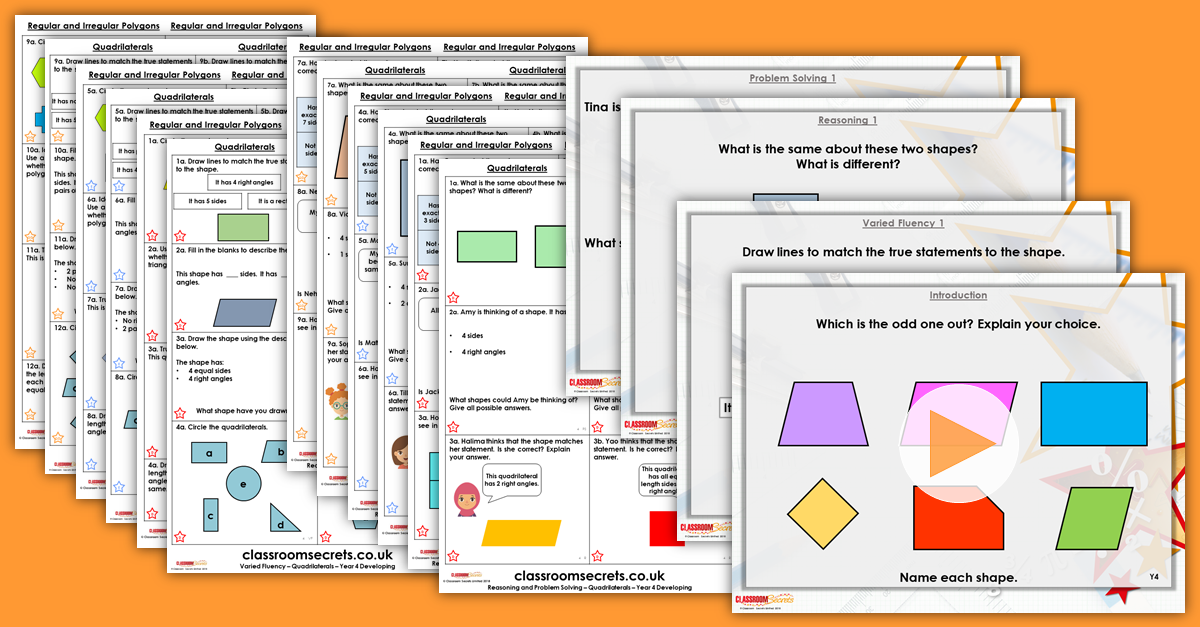Mixed Age Year 4 and 5 Properties of Shape Step 8 Resource Pack

Step 8: Mixed Age Year 4 and 5 Properties of Shape Step 8
Mixed Age Year 4 and 5 Properties of Shape Step 8 Resource Pack includes a teaching PowerPoint and differentiated varied fluency and reasoning and problem solving resources for this step which covers Year 4 Quadrilaterals & Year 5 Regular and Irregular Polygons for Summer Block 4.
Not a member? Sign up here.
What's included in the Pack?
This Mixed Age Year 4 and 5 Properties of Shape Step 8 pack includes:
- Mixed Age Year 4 and 5 Properties of Shape Step 8 Teaching PowerPoint with examples.
- Year 4 Quadrilaterals Varied Fluency with answers.
- Year 4 Quadrilaterals Reasoning and Problem Solving with answers.
- Year 5 Regular and Irregular Polygons Varied Fluency with answers.
- Year 5 Regular and Irregular Polygons Reasoning and Problem Solving with answers.
National Curriculum Objectives
Mathematics Year 4: (4G2a) Compare and classify geometric shapes, including quadrilaterals and triangles based on their properties and sizes
Mathematics Year 5: (5G2b) Distinguish between regular and irregular polygons based on reasoning about equal sides and angles
Differentiation for Year 4 Quadrilaterals:
Varied Fluency
Developing Questions to support identifying and describing the properties of quadrilaterals. Including right angles and 3 types of quadrilateral (rectangles, parallelograms, and squares). All shapes in ‘standard’ orientation.
Expected Questions to support identifying and describing the properties of quadrilaterals. Including right angles, parallel lines and 5 types of quadrilateral (rectangles, parallelograms, squares, trapeziums and rhombus). All shapes in ‘standard’ orientation.
Greater Depth Questions to support identifying and describing the properties of irregular quadrilaterals. Including right angles, parallel lines and 5 types of quadrilateral (rectangles, parallelograms, squares, trapeziums and rhombus). Shapes presented in different orientations.
Reasoning and Problem Solving
Questions 1, 4 and 7 (Reasoning)
Developing Describe the similarities and differences between two quadrilaterals. Includes right angles and 3 types of quadrilateral (rectangles, parallelograms and squares). All shapes are in ‘standard’ orientation.
Expected Describe the similarities and differences of two quadrilaterals. Includes right angles, parallel lines and 5 types of quadrilateral (rectangles, parallelograms, squares, trapeziums and rhombus). All shapes are in ‘standard’ orientation.
Greater Depth Describe the similarities and differences of two quadrilaterals using understanding of quadrilaterals and their properties. Includes rights angles, parallel lines and 5 types of quadrilateral (rectangles, parallelograms, squares, trapeziums and rhombus). Shapes presented in different orientations.
Questions 2, 5 and 8 (Problem Solving)
Developing Work out the shape based on the properties given. Properties relate to 3 types of quadrilateral (rectangles, parallelograms and squares), sides and right angles.
Expected Work out the shape based on the properties given. Properties relate to 5 types of quadrilateral (rectangles, parallelograms, squares, trapeziums and rhombus), parallel lines and right angles.
Greater Depth Work out the shape based on the properties given. Properties relate to 5 types of quadrilateral (rectangles, parallelograms, squares, trapeziums and rhombus), parallel lines and right angles.
Questions 3, 6 and 9 (Reasoning)
Developing Explain whether a statement describing or identifying a quadrilateral is correct. Includes right angles and 3 types of quadrilateral (rectangles, parallelograms and squares). All shapes are in ‘standard’ orientation.
Expected Explain whether a statement describing or identifying a quadrilateral is correct. Includes right angles, parallel lines and 5 types of quadrilateral (rectangles, parallelograms, squares, trapeziums and rhombus). All shapes are in ‘standard’ orientation.
Greater Depth Explain whether a statement describing or identifying a quadrilateral is correct. Includes right angles, parallel lines and 5 types of quadrilateral (rectangles, parallelograms, squares, trapeziums and rhombus). Shapes presented in different orientations.
Differentiation for Year 5 Regular and Irregular Polygons:
Varied Fluency
Developing Questions to support being able to distinguish between regular and irregular polygons. Using regular and irregular triangles and quadrilaterals.
Expected Questions to support being able to distinguish between regular and irregular polygons. Using regular and irregular quadrilaterals, pentagons and hexagons.
Greater Depth Questions to support being able to distinguish between regular and irregular polygons. Includes all polygons up to decagons.
Reasoning and Problem Solving
Questions 1, 4 and 7 (Reasoning)
Developing Explain whether regular and irregular polygons have been sorted correctly. 5 polygons to investigate with 1 or 2 errors to find. Using regular and irregular triangles, quadrilaterals, pentagons and hexagons.
Expected Explain whether regular and irregular polygons have been sorted correctly. 5 or 6 polygons to investigate with 2 or 3 errors to find. Using regular and irregular triangles, quadrilaterals, pentagons, hexagons, octagons and a circle.
Greater Depth Explain whether regular and irregular polygons have been sorted correctly. 7 polygons to investigate with 3 errors to find. Includes all polygons up to decagons and some non-polygon shapes.
Questions 2, 5 and 8 (Reasoning)
Developing Explain whether a child has described a polygon correctly. Using regular and irregular triangles and quadrilaterals.
Expected Explain whether a child has described a polygon correctly. Using regular and irregular pentagons and hexagons.
Greater Depth Explain whether a child has described a polygon correctly. Includes polygons up to decagons.
Questions 3, 6 and 9 (Problem Solving)
Developing Investigate how many regular polygons can be found in a shape. Using regular and irregular triangles and quadrilaterals.
Expected Investigate how many regular polygons can be found in a shape. Using regular and irregular triangles, quadrilaterals, pentagons and hexagons.
Greater Depth Investigate how many regular polygons can be found in a shape. Includes all polygons up to decagons.
This resource is available to download with a Premium subscription.






